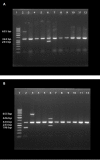Toxinotyping and Antimicrobial Resistance of Clostridium Perfringens Isolated from Processed Chicken Meat Products
- PMID: 29978055
- PMCID: PMC5894406
- DOI: 10.1515/jvetres-2017-0007
Toxinotyping and Antimicrobial Resistance of Clostridium Perfringens Isolated from Processed Chicken Meat Products
Abstract
Introduction: The toxinotyping and antimicrobial susceptibility of Clostridium perfringens strains isolated from processed chicken meat were determined.
Material and methods: Two hundred processed chicken meat samples from luncheon meats, nuggets, burgers, and sausages were screened for Clostridium perfringens by multiplex PCR assay for the presence of alpha (cpa), beta (cpb), epsilon (etx), iota (ia), and enterotoxin toxin (cpe) genes. The C. perfringens isolates were examined in vitro against eight antibiotics (streptomycin, amoxicillin, ampicillin, ciprofloxacin, lincomycin, cefotaxime, rifampicin, and trimethoprim-sulfamethoxazole).
Results: An overall of 32 C. perfringens strains (16%) were isolated from 200 processed chicken meat samples tested. The prevalence of C. perfringens was significantly dependent on the type of toxin genes detected (P = 0.0), being the highest in sausages (32%), followed by luncheon meats (24%), burgers (6%), and nuggets (2%). C. perfringens type A was the most frequently present toxinotype (24/32; 75%), followed by type D (21.9 %) and type E (3.1%). Of the 32 C. perfringens strains tested, only 9 (28%) were enterotoxin gene carriers, with most representing type A (n = 6). C. perfringens strains differed in their resistance/susceptibility to commonly used antibiotics. Most of the strains tested were sensitive to ampicillin (97%) and amoxicillin (94%), with 100% of the strains being resistant to streptomycin and lincomycin. It is noteworthy that the nine isolates with enterotoxigenic potential had a higher resistance than the non-enterotoxigenic ones.
Conclusion: The considerably high C. perfringens isolation rates from processed chicken meat samples and resistance to some of the commonly used antibiotics indicate a potential public health risk. Recent information about the isolation of enterotoxigenic C. perfringens type E from chicken sausage has been reported.
Keywords: Clostridium perfringens; antimicrobial resistance; enterotoxin; processed chicken meat.
Conflict of interest statement
Conflict of Interests Statement: The authors declare that there is no conflict of interests regarding the publication of this article.
Figures

Similar articles
-
Isolation, toxinotyping and antimicrobial susceptibility testing of Clostridium perfringens isolated from Pakistan poultry.Anaerobe. 2022 Feb;73:102499. doi: 10.1016/j.anaerobe.2021.102499. Epub 2021 Dec 8. Anaerobe. 2022. PMID: 34890812
-
Toxinotyping and antimicrobial susceptibility of enterotoxigenic Clostridium perfringens isolates from mutton, beef and chicken meat.J Food Sci Technol. 2015 Aug;52(8):5323-8. doi: 10.1007/s13197-014-1584-3. Epub 2014 Sep 24. J Food Sci Technol. 2015. PMID: 26243960 Free PMC article.
-
Prevalence, toxin-typing, and antimicrobial susceptibility of Clostridium perfringens from retail meats in Seoul, Korea.Anaerobe. 2020 Aug;64:102235. doi: 10.1016/j.anaerobe.2020.102235. Epub 2020 Jun 30. Anaerobe. 2020. PMID: 32619505
-
Comparative pathogenesis of enteric clostridial infections in humans and animals.Anaerobe. 2018 Oct;53:11-20. doi: 10.1016/j.anaerobe.2018.06.002. Epub 2018 Jun 5. Anaerobe. 2018. PMID: 29883627 Free PMC article. Review.
-
Expansion of the Clostridium perfringens toxin-based typing scheme.Anaerobe. 2018 Oct;53:5-10. doi: 10.1016/j.anaerobe.2018.04.011. Epub 2018 Apr 20. Anaerobe. 2018. PMID: 29866424 Free PMC article. Review.
Cited by
-
Emergence of genetic diversity and multi-drug resistant Clostridium perfringens from wild birds.BMC Vet Res. 2024 Jul 6;20(1):300. doi: 10.1186/s12917-024-04168-8. BMC Vet Res. 2024. PMID: 38971814 Free PMC article.
-
Dosing Regimen of Aditoprim and Sulfamethoxazole Combination for the Glaesserella parasuis Containing Resistance and Virulence Genes.Pharmaceutics. 2022 Sep 27;14(10):2058. doi: 10.3390/pharmaceutics14102058. Pharmaceutics. 2022. PMID: 36297496 Free PMC article.
-
Resistance of Gram-Positive Bacteria to Current Antibacterial Agents and Overcoming Approaches.Molecules. 2020 Jun 23;25(12):2888. doi: 10.3390/molecules25122888. Molecules. 2020. PMID: 32586045 Free PMC article. Review.
-
Prevalence and multilocus sequence typing of Clostridium perfringens isolated from retail chicken products and diseased chickens in Tai'an region, China.Vet Med Sci. 2021 Nov;7(6):2339-2347. doi: 10.1002/vms3.616. Epub 2021 Sep 18. Vet Med Sci. 2021. PMID: 34535963 Free PMC article.
-
Alpha toxin production potential and antibiotic resistance patterns of clostridium perfringens isolates from meat samples.Anim Biosci. 2024 Nov;37(11):1970-1978. doi: 10.5713/ab.24.0210. Epub 2024 Jun 25. Anim Biosci. 2024. PMID: 38938034 Free PMC article.
References
-
- Abd-El Gwad A.M., Abd El-Kader H.A.. The occurrence of Clostridium perfringens in the intestine of broiler chickens Assiut governorate. Ass Univ Bull Environ Res. 2001;4:13–22.
-
- Abd El-Hamid H.S., Ellakany H.F., Aboelmagd B.A., Elbestawy A.R., Bedawy Sh.. Clinical and laboratory studies on chicken isolates of Clostridium perfringens in El-Behera, Egypt. J World's Poult Res. 2015;5:21–28.
-
- Ata N., Khairy E.A., Dorgham S.M., Zaki M.S.. Clostridium perfringens disease. Life Sci J. 2013;10:1599–1602.
-
- Bos J., Smithee L., McClane B., Distefano R.F., Uzal F.. Fatal necrotizing colitis following a foodborne outbreak of enterotoxigenic Clostridium perfringens type A infection. Clin Infect Dis. 2005;40:78–83. - PubMed
LinkOut - more resources
Full Text Sources
Other Literature Sources
Research Materials
Miscellaneous
